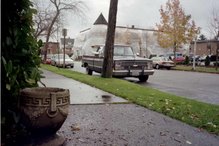At 140-some dollars a month, according to the internet, Mary’s
rent in Minneapolis (twice what I paid in student housing at the time for a
room) was close to low income housing for the time. Low income housing has changed because old
houses are now historic buildings. Nickel and Dimed describes how meager the
low-income reality is. Mary and her
neighbor Rhoda were portrayed by beautiful actresses, but the story they told
was about working women.
 |
| Cookies with decals on tiles |
2. Tuesday evening the security guard said there was a reading
of Nickel and Dimed at seven.
I said I was sorry to not have anything left. The Tuesday before, after returning from the
volunteer job at PLU I saw Barbara Ehrenreich interviewed by a moderator from TV
Tacoma.
At McDonald’s, in a tiny rain, I remembered other reading group discussions, when I spoke
of how anxious I had been, when a new building nearby was not a Marlene’s Market. (It was a new McDonald’s, they later
destroyed the old one.)
I had not told the truth.
I had something left: two cookies,
leftover from thawed lunch cookies I made Saturday for Sunday, when the church
installed the new minister. A flock of
ministers processed, then cookies and punch. They used about half, and since they had bales
I carried my own cookies back.
I stood on the sidewalk, ate the two cookies, then walked
back.
The little rain on the pants I had worn at the volunteer job
at PLU evaporated pretty soon, I did not catch cold, actors read a script of the story aloud, they enunciated
very well, it was easy to understand. It
was an interesting evening.
 |
| Cookies at church |
And at eight-thirty it was not raining as I walked back.
3. Nearly thirty years after 1970, gentrification had followed.
Barbara Ehrenreich’s Nickel and Dimed in part is in Minneapolis. Again on the internet, photos inside the restored actual Mary Tyler
Moore Show house today are accompanied by a comment in the spirit of
gentrification – “I hate seeing a house turned into apartments…” I have been impressed with the similarity of Mary
Tyler Moore Show’s setting, because I
lived in houses turned into rooming houses and apartments throughout college
and after as a Master of Fine Arts Degree recipient who worked self-employed. (I think it is permissible: I saved but do
not plan to publish two photos of a remodeled unit where I lived for
years, it is very gentrified. It now has a tiny stairs up to a
loft.)
Low income housing shortage and high cost make me wonder if
turning houses into housing might work if clusters of smaller houses were
remodeled to accommodate single workers.
A row of three houses might include sleeping rooms with the house in the
center offering residents board and a living room area. In my idea of this, management would have
strong oversight, perhaps by organizations that support low-income workers.


No comments:
Post a Comment